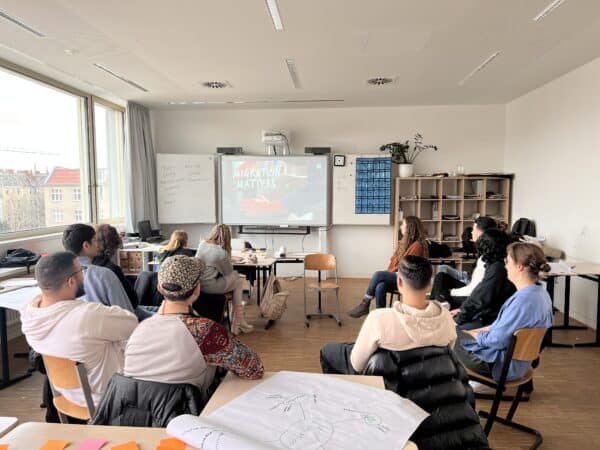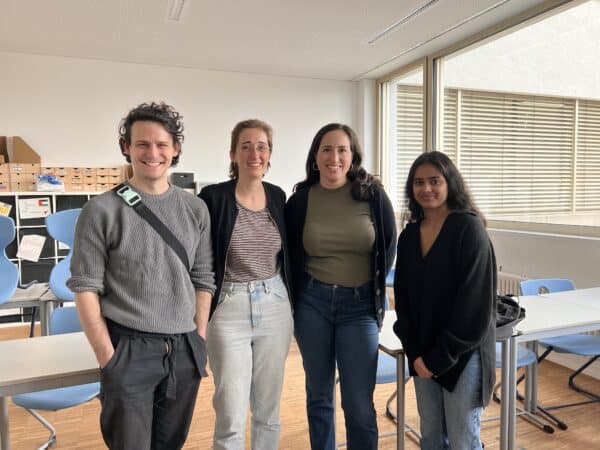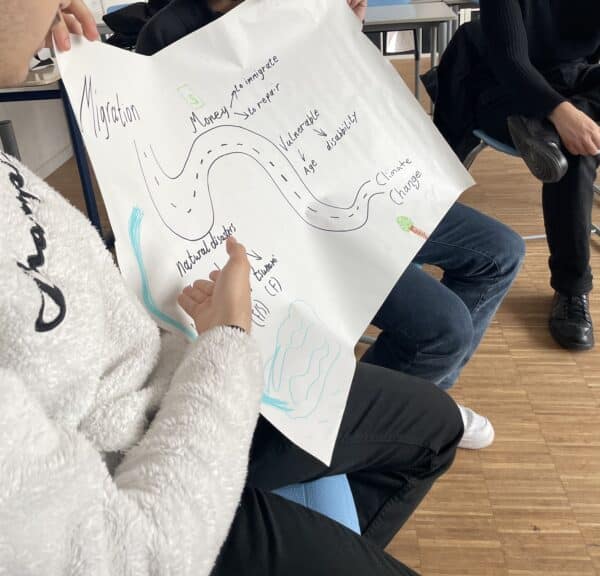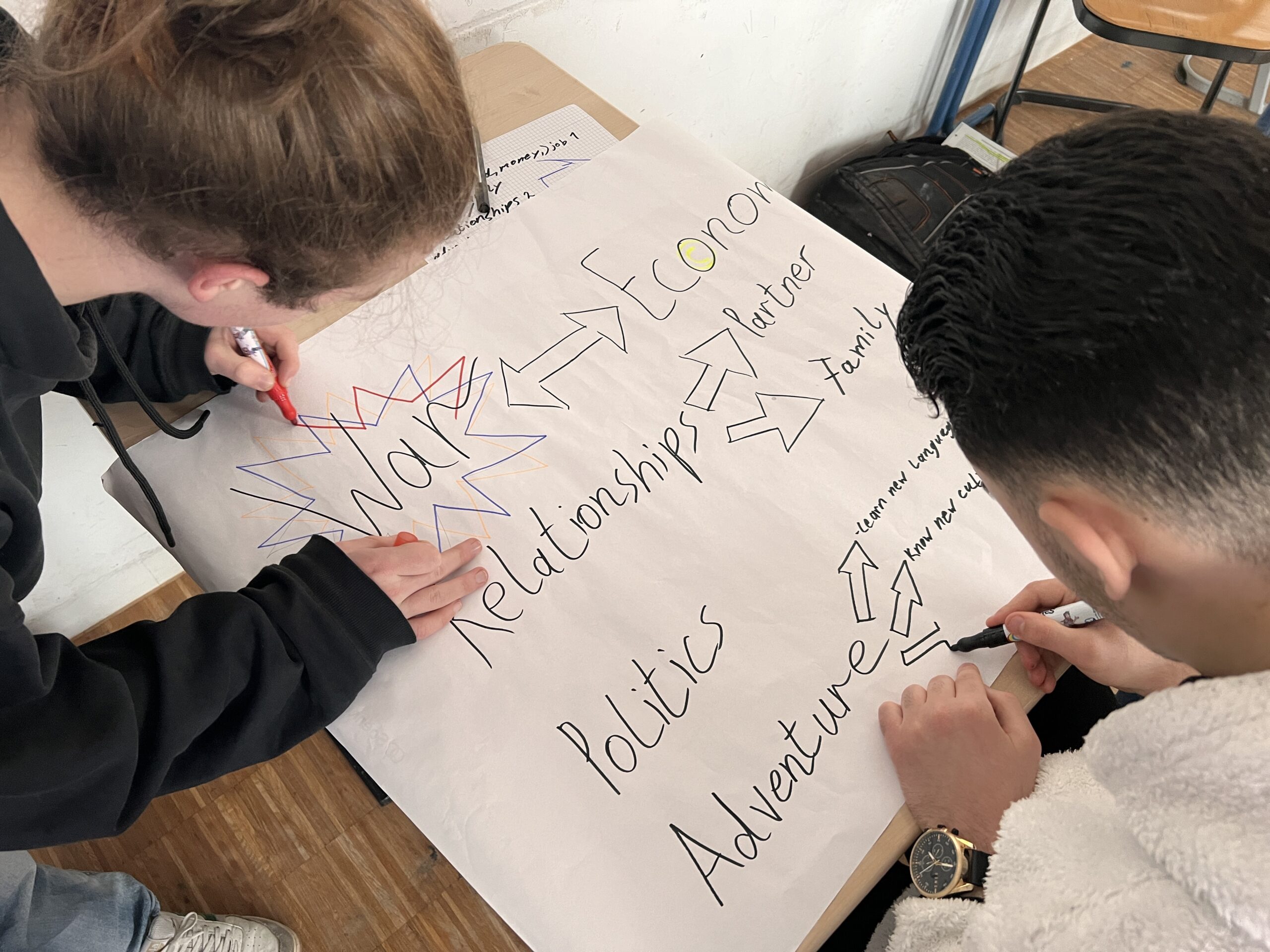By Saniya Patel
While it has become abundantly clear that climate change is real and affects people in all corners of the world, its complex relationship to migration is often oversimplified in the larger public narrative. As an attempt to expose students to this issue, we recently held two back-to-back high school workshops at Campus Rütli high school in Berlin-Neukölln, which focused on understanding the reasons behind migration and the connection between climate change and migration. The two interactive workshops were conducted by co-founder Sophia Burton, researcher Julia Stier from the Berlin Social Science Center (WZB), and climate scientist Adam Levy, for a group of 13 students between the ages of 17-18 in an English class.

Watching a Migration Matters video
The workshops aimed to explore the numerous (and often multi-causal) reasons for why people migrate and introduce students to climate change as a driving force behind migration and “threat multiplier” for other reasons for migration. Ultimately, we aimed to prompt a discussion around this crucial topic so that students are aware of and can contribute to the ongoing narrative in a more nuanced way.
On the first day, Sophia Burton and Julia Stier started with the basics, asking students to guess the percentage of the world population that makes up international migrants. As do most people, the students’ guesses ranged between 10% and 76%. They were later shocked to find out that the actual number is only 3.6% and that less than 1% are refugees, with labor demand being the biggest reason for migration. During the workshop, students also discussed the reasons to migrate and categorized migration motives, largely focusing on the concept of multi-causality, or multiple reasons for migration.

Writing out reasons for migration
On the second day, Sophia Burton and Adam Levy of Climate Adam introduced the students to the topic of climate-induced migration. The first activity was an ice-breaker session: Images of four different climate catastrophes were projected on the whiteboard, and in small groups, students were to guess what the catastrophe was and where it occurred. The idea was to introduce them to the concept of “slow” and “fast” events and what fits into each category. This sparked thorough discussions within groups as they studied each picture, debating the events represented. The names of the events were written on the whiteboard beforehand for reference. This activity came from the Teaching Immigration in European Schools (TIES) module on climate change and migration and is freely available for teachers to use.

Day 2 workshop team (from left): Adam Levy (climate scientist), Eva Degler (teacher), Sophia Burton and Saniya Patel (MM)
As we transitioned into our next activity, we were impressed to see how often students made connections to the topics covered the day before. For this activity, we screened our video “Is there a link between climate change and migration?” and introduced the students to terms like “multi-causal,” “perception,” “threat,” and “irreversible,” beforehand, to make them well-versed in the vocabulary used in the video.
For the third activity, we screened the video “What can we learn from fishermen in Senegal?” which introduced the students to the term “vulnerable” and what it means in the context of environmental migration. The students fully engaged themselves with the video and were able to pinpoint the main points covered in it. We were happy to see that some students also addressed these points in the next activity.

Drawing the link between climate change and migration
The drawing activity was the final and perhaps the most fun task for the students, as they could showcase their creativity. Students were divided into three groups and given 15 minutes to brainstorm and draw on paper the complex connection between climate change and migration, using concepts from the video screening. They were then asked to present their drawing, ranging from mind maps to images like roads, the sun, and waves. One group drew a duck to reflect the migration of fish in the Guet N’dar neighborhood in Senegal, as shown in the Migration Matters video, which caused local fishermen to migrate to nearby areas. Another group connected the reasons for migration to climate change by revisiting the concept of slow and fast events. An important detail in their drawing was to show this link using a squiggly line. Through this, they raised a crucial point that while climate change does impact migration, it is difficult to make a direct link between the two.
Thank you to Eva Degler, the students’ teacher, for inviting us to give these workshops to her students. This workshop series is supported by the Friends of the WZB (Social Science Center Berlin) and Deutsche Postcode Lotterie. If you’re interested in holding a workshop at your school, reach out to us at team@migrationmatters.me and include “school workshop” in the subject line.
